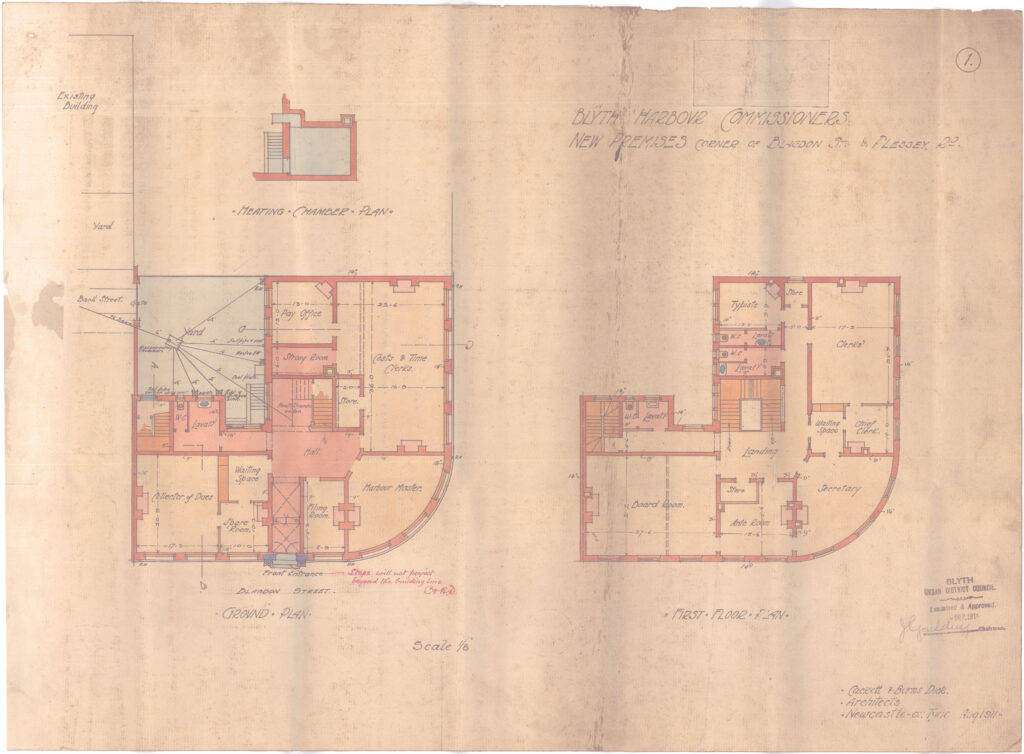Plan of Harbour Commissioners’ Building, Blyth, 1911
Reference: LBB/G/2/1258
Suggested age groups: KS1, KS2, KS3, KS4, lifelong learners
Subject areas: Industrial Development, Architecture
CONTEXT
In 1911 the Blyth Harbour Commissioners submitted these plans for a new building to Blyth Borough Council. The architects formally handed over the building to the Harbour Commissioners in July 1913. This building can still be seen on the B1329, near the Kings Head Café and exhibition space.
An act of parliament of 1882 created the Blyth Harbour Commissioners. The Commissioners are a trust which are responsible of the running of the port. They make sure that it is safe for ships to use.
In February 1913, the number of Commissioners was increased from 13 to 19. As of 2022 there are six Harbour Commissioners.
Clerk – person employed by the Harbour Commissioners to do administrational tasks (admin).
Secretary – directly responsible to the Harbour Commissioners. Arranges meetings of the Commissioners and the recording of their meetings (minutes). Prestigious position with legal responsibilities.
Typists – people employed to type reports, letters and other documents on typewriters. Typing accurately and quickly on a typewriter required skill and training.
Harbour master – in charge of the safe running of the port on a day-to-day basis.
Collector of dues – person employed by the Harbour Commissioners to oversee payments made by ships that used the port
Cost and time clerks – admin employees specially trained to make calculations relating to time and money.
Board – the Harbour Commissioners.
ACTIVITIES
ACTIVITY 1
Background
In 1911 the Blyth Harbour Commissioners submitted these plans for a new building to Blyth Borough Council.
An act of parliament of 1882 created the Blyth Harbour Commissioners.
In February 1913, the number of Commissioners was increased from 13 to 19. As of 2022 there are six Harbour Commissioners.
SEE
See: What is a Harbour Commissioner?
See: What do Harbour Commissioners do?
See: When and how were the Blyth Harbour Commissioners created?
See: How did the number of Commissioners change in 1913?
See: How had the number of Commissioners changed by 2022?
THINK
Think: What took place in this building?
Think: Is this building still used as the Harbour Commissioners’ Building today?
Think: What takes place in this building today?
Think: Why are Harbour Commissioners important?
Think: Why were Harbour Commissioners established?
Think: What is a Harbour Master?
Think: How does the Harbour Master differ from Harbour Commissioners?
Think: Why has the number of Harbour Commissioners changed over time?
DO
Do: Create word and definition cards for each of the words that are in the vocabulary section. Try to match the words to their definitions.
Do: Discuss the role that the Harbour Commissioners had in 1913.
Do: Make a list of the names of the Blyth Harbour Commissioners in 1913.
Do: Make a list of the present-day Blyth Harbour Commissioners.
Do: Discuss the role that harbour Commissioners have today.
Do: Discuss what you think took place in each of the different rooms.
Do: Create a portrait and a job profile for someone who might have worked in one of the different roles in different parts of the building.
Do: Discuss what you can infer about industry in Blyth from the development of this building.
Do: Discuss what you can infer about industry in Blyth from the increase in numbers of Harbour Commissioners in 1913.
Do: Discuss what you can infer about industry in Blyth from the decrease in numbers of Harbour Commissioners by 2022.
Resources
ACTIVITY 2
Background
In 1911 the Blyth Harbour Commissioners submitted these plans for a new building to Blyth Borough Council. The architects formally handed over the building to the Harbour Commissioners in July 1913. This building can still be seen on the B1329.
SEE
See: What is this a plan for?
See: What rooms are shown on the plan?
See: When is this plan from?
See: When was the building formally handed over to the Blyth Harbour Commissioners?
THINK
Think: What does the building look like?
Think: What architectural style is this building designed in?
Think: Why is the front of the building curved?
Think: Do other places have Harbour Commissioners?
DO
Do: Choose one of the rooms from the plan. Design what the interior of the room might have looked like.
Do: Look at a photograph or Google Street View of the Harbour Commissioners’ Building. Can you find any architecture from the plans or where each of the rooms might be?
Do: Make a word cloud of the words that you would use to describe the exterior of the building. How does it make you feel? Does it look welcoming or foreboding? Does it look similar to the other buildings nearby? Does it have any interesting details?
Do: Look at the Port of Blyth offices – the present-day offices for Blyth’s Harbour Commissioners. Compare this building to the Harbour Commissioners’ Building.
Do: Make a list of the job roles that you think will take place in the Port of Blyth offices. Are these similar or different to the Harbour Commissioners’ Building in 1911?
Do: Create a mood board showing what other Harbour Commissioners’ buildings look like elsewhere in the country. Annotate the designs to show how their similarities and differences, and what you like and dislike about each of them.
Do: Design your own Harbour Commissioners’ Building.
Do: Make a model of your building.
Resources
OTHER ONLINE RESOURCES
Building History website, page about building control plans: https://www.buildinghistory.org/regulations.shtml
Port of Blyth website, page about current Harbour Commissioners: https://portofblyth.co.uk/about/constitution-board/
Port of Blyth website, page about the history of the port: https://portofblyth.co.uk/about/history/
Port of Blyth website, news item about new Harbour Master (2019): https://portofblyth.co.uk/all-change-harbour-master-takes-new-role/
Port of Blyth Archive website, includes searchable catalogue: https://www.blythmaritimearchive.org.uk/


